Analyzing Tesco's Employment Policies and Gender Pay Disparity
VerifiedAdded on 2023/04/21
|39
|11660
|431
Project
AI Summary
This project is a dissertation analyzing the gender pay gap at Tesco Plc, UK, investigating the impact of the company's employment policies on pay disparity. The research begins with an executive summary and introduction, highlighting the significance of addressing the gender pay gap and the role of well-written employment policies. A literature review explores the factors contributing to the pay gap, including human capital and undervaluation theories. The methodology chapter details the research approach, philosophy, design, and data collection/analysis methods. The findings reveal the extent of the pay gap at Tesco, identifying factors leading to wage disparities among male and female employees, and the institutionalized undervaluation. The conclusion provides recommendations for addressing the issue. The study aims to examine the gender pay gap, investigate the underlying factors of disparity, and assess the impact of unequal wages on the female workforce, offering insights for Tesco's HR managers and supervisors to improve policies and strategies. The dissertation includes tables of content, references and is a comprehensive analysis of Tesco's employment policies and their impact on closing the gender pay gap.
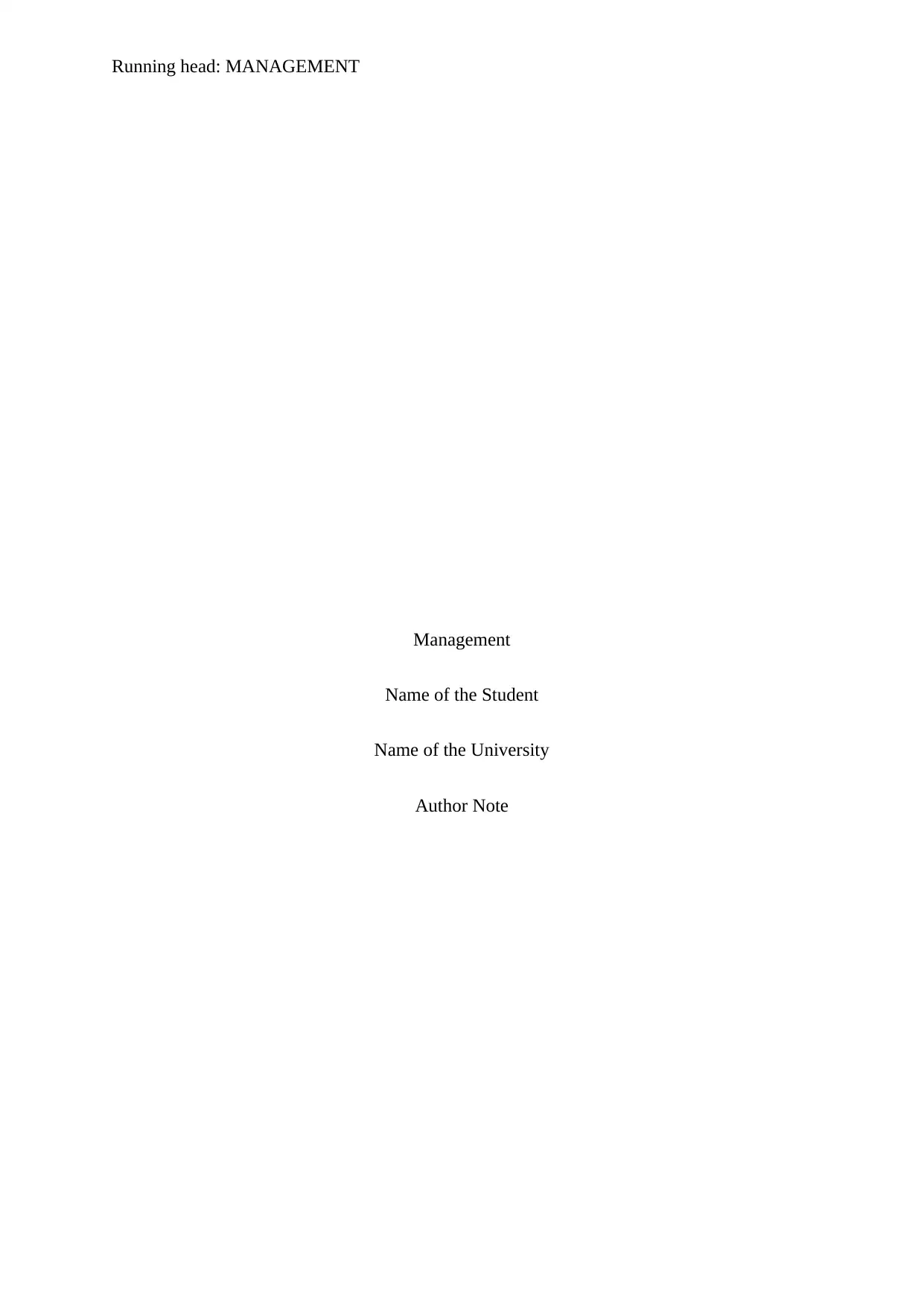
Running head: MANAGEMENT
Management
Name of the Student
Name of the University
Author Note
Management
Name of the Student
Name of the University
Author Note
Paraphrase This Document
Need a fresh take? Get an instant paraphrase of this document with our AI Paraphraser
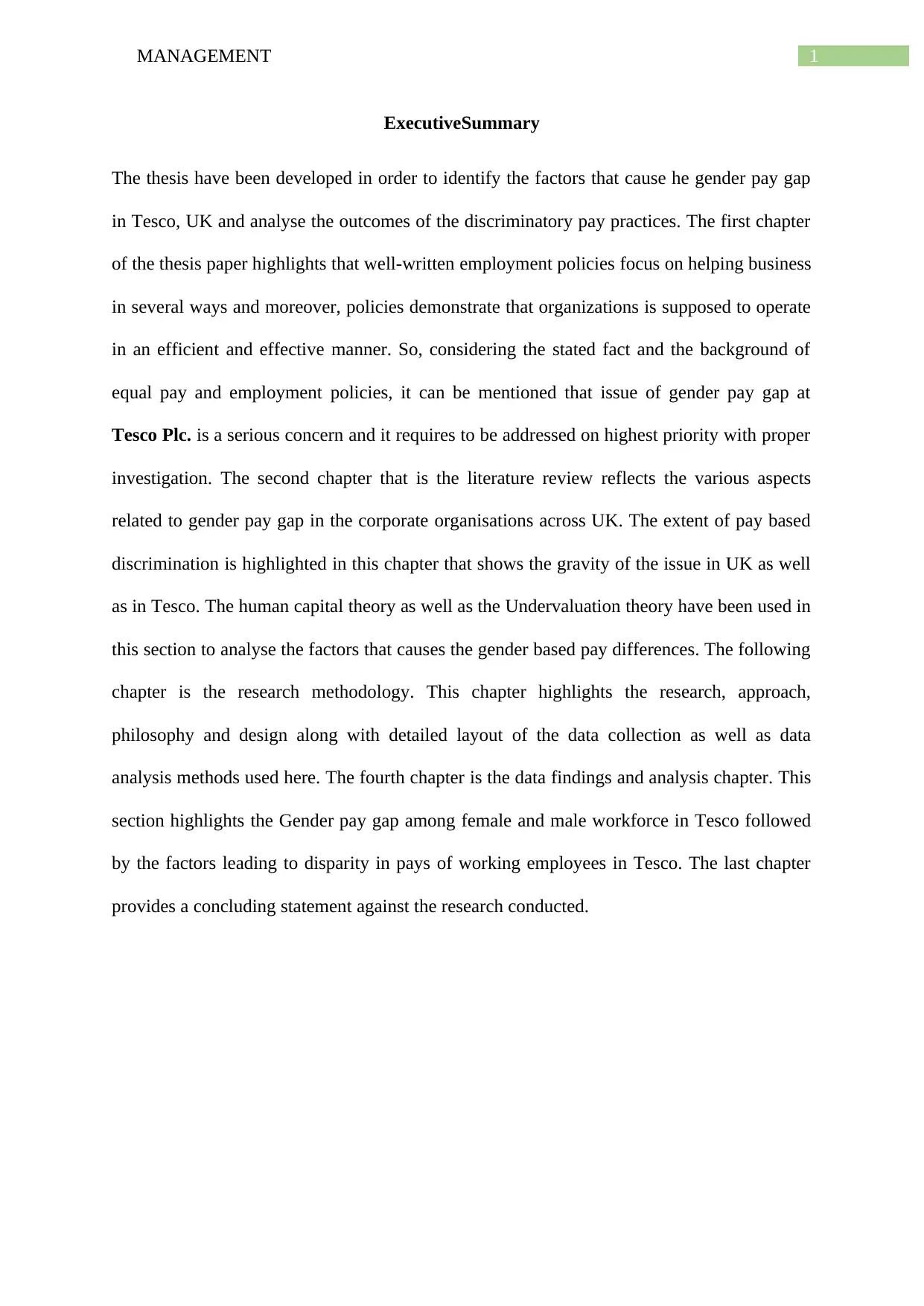
1MANAGEMENT
ExecutiveSummary
The thesis have been developed in order to identify the factors that cause he gender pay gap
in Tesco, UK and analyse the outcomes of the discriminatory pay practices. The first chapter
of the thesis paper highlights that well-written employment policies focus on helping business
in several ways and moreover, policies demonstrate that organizations is supposed to operate
in an efficient and effective manner. So, considering the stated fact and the background of
equal pay and employment policies, it can be mentioned that issue of gender pay gap at
Tesco Plc. is a serious concern and it requires to be addressed on highest priority with proper
investigation. The second chapter that is the literature review reflects the various aspects
related to gender pay gap in the corporate organisations across UK. The extent of pay based
discrimination is highlighted in this chapter that shows the gravity of the issue in UK as well
as in Tesco. The human capital theory as well as the Undervaluation theory have been used in
this section to analyse the factors that causes the gender based pay differences. The following
chapter is the research methodology. This chapter highlights the research, approach,
philosophy and design along with detailed layout of the data collection as well as data
analysis methods used here. The fourth chapter is the data findings and analysis chapter. This
section highlights the Gender pay gap among female and male workforce in Tesco followed
by the factors leading to disparity in pays of working employees in Tesco. The last chapter
provides a concluding statement against the research conducted.
ExecutiveSummary
The thesis have been developed in order to identify the factors that cause he gender pay gap
in Tesco, UK and analyse the outcomes of the discriminatory pay practices. The first chapter
of the thesis paper highlights that well-written employment policies focus on helping business
in several ways and moreover, policies demonstrate that organizations is supposed to operate
in an efficient and effective manner. So, considering the stated fact and the background of
equal pay and employment policies, it can be mentioned that issue of gender pay gap at
Tesco Plc. is a serious concern and it requires to be addressed on highest priority with proper
investigation. The second chapter that is the literature review reflects the various aspects
related to gender pay gap in the corporate organisations across UK. The extent of pay based
discrimination is highlighted in this chapter that shows the gravity of the issue in UK as well
as in Tesco. The human capital theory as well as the Undervaluation theory have been used in
this section to analyse the factors that causes the gender based pay differences. The following
chapter is the research methodology. This chapter highlights the research, approach,
philosophy and design along with detailed layout of the data collection as well as data
analysis methods used here. The fourth chapter is the data findings and analysis chapter. This
section highlights the Gender pay gap among female and male workforce in Tesco followed
by the factors leading to disparity in pays of working employees in Tesco. The last chapter
provides a concluding statement against the research conducted.
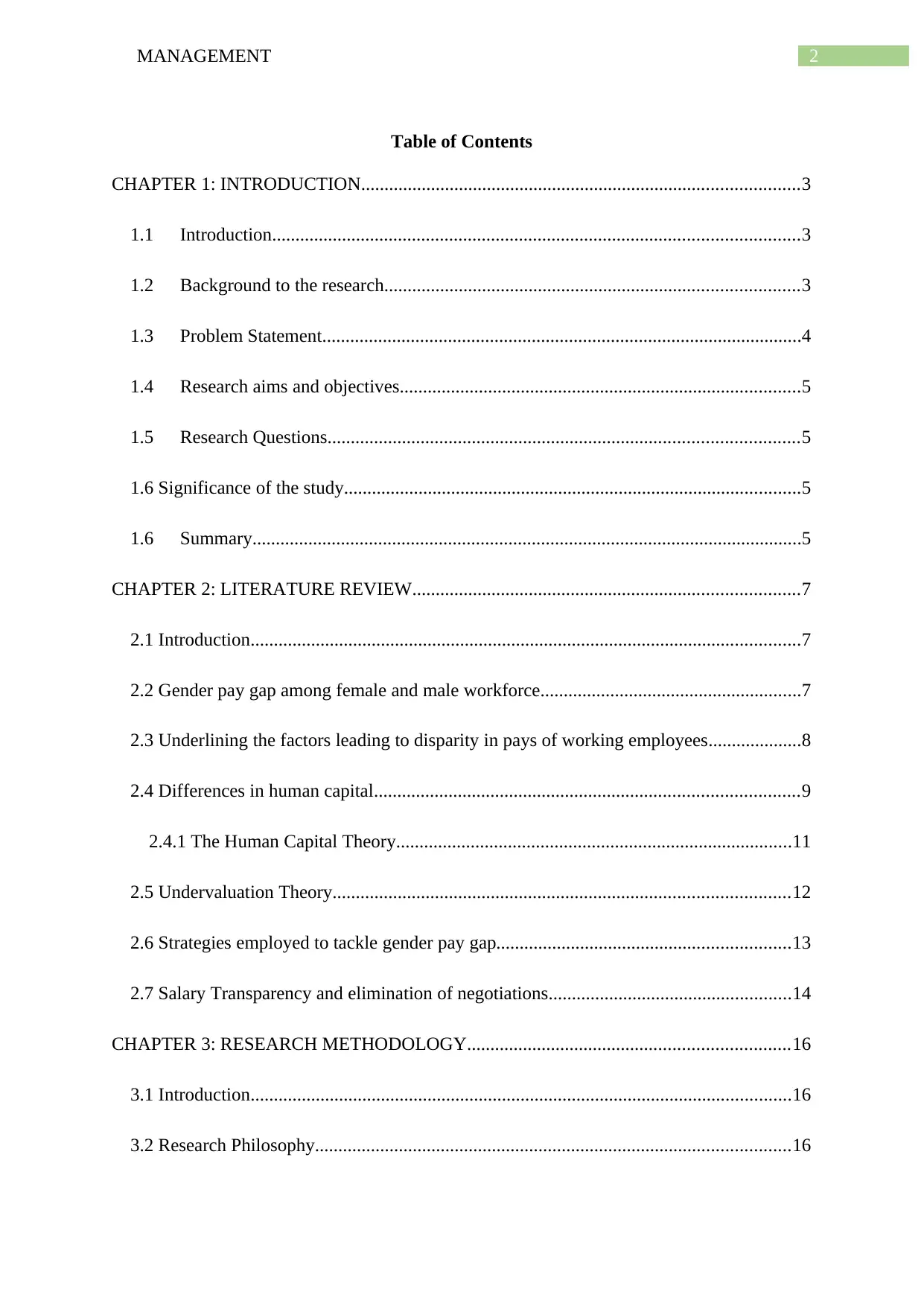
2MANAGEMENT
Table of Contents
CHAPTER 1: INTRODUCTION..............................................................................................3
1.1 Introduction.................................................................................................................3
1.2 Background to the research.........................................................................................3
1.3 Problem Statement.......................................................................................................4
1.4 Research aims and objectives......................................................................................5
1.5 Research Questions.....................................................................................................5
1.6 Significance of the study..................................................................................................5
1.6 Summary......................................................................................................................5
CHAPTER 2: LITERATURE REVIEW...................................................................................7
2.1 Introduction......................................................................................................................7
2.2 Gender pay gap among female and male workforce........................................................7
2.3 Underlining the factors leading to disparity in pays of working employees....................8
2.4 Differences in human capital...........................................................................................9
2.4.1 The Human Capital Theory.....................................................................................11
2.5 Undervaluation Theory..................................................................................................12
2.6 Strategies employed to tackle gender pay gap...............................................................13
2.7 Salary Transparency and elimination of negotiations....................................................14
CHAPTER 3: RESEARCH METHODOLOGY.....................................................................16
3.1 Introduction....................................................................................................................16
3.2 Research Philosophy......................................................................................................16
Table of Contents
CHAPTER 1: INTRODUCTION..............................................................................................3
1.1 Introduction.................................................................................................................3
1.2 Background to the research.........................................................................................3
1.3 Problem Statement.......................................................................................................4
1.4 Research aims and objectives......................................................................................5
1.5 Research Questions.....................................................................................................5
1.6 Significance of the study..................................................................................................5
1.6 Summary......................................................................................................................5
CHAPTER 2: LITERATURE REVIEW...................................................................................7
2.1 Introduction......................................................................................................................7
2.2 Gender pay gap among female and male workforce........................................................7
2.3 Underlining the factors leading to disparity in pays of working employees....................8
2.4 Differences in human capital...........................................................................................9
2.4.1 The Human Capital Theory.....................................................................................11
2.5 Undervaluation Theory..................................................................................................12
2.6 Strategies employed to tackle gender pay gap...............................................................13
2.7 Salary Transparency and elimination of negotiations....................................................14
CHAPTER 3: RESEARCH METHODOLOGY.....................................................................16
3.1 Introduction....................................................................................................................16
3.2 Research Philosophy......................................................................................................16
⊘ This is a preview!⊘
Do you want full access?
Subscribe today to unlock all pages.

Trusted by 1+ million students worldwide
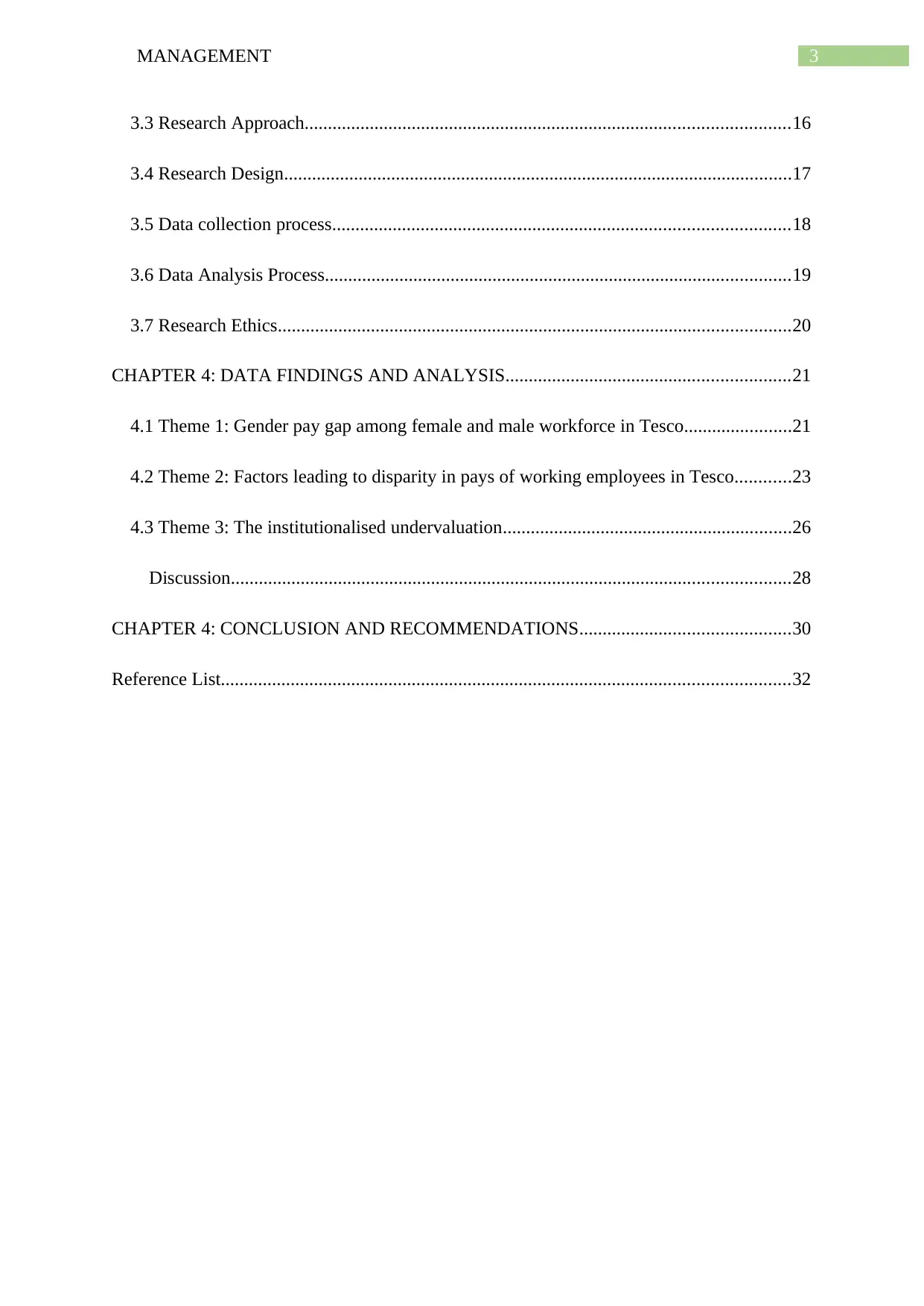
3MANAGEMENT
3.3 Research Approach........................................................................................................16
3.4 Research Design.............................................................................................................17
3.5 Data collection process..................................................................................................18
3.6 Data Analysis Process....................................................................................................19
3.7 Research Ethics..............................................................................................................20
CHAPTER 4: DATA FINDINGS AND ANALYSIS.............................................................21
4.1 Theme 1: Gender pay gap among female and male workforce in Tesco.......................21
4.2 Theme 2: Factors leading to disparity in pays of working employees in Tesco............23
4.3 Theme 3: The institutionalised undervaluation..............................................................26
Discussion........................................................................................................................28
CHAPTER 4: CONCLUSION AND RECOMMENDATIONS.............................................30
Reference List..........................................................................................................................32
3.3 Research Approach........................................................................................................16
3.4 Research Design.............................................................................................................17
3.5 Data collection process..................................................................................................18
3.6 Data Analysis Process....................................................................................................19
3.7 Research Ethics..............................................................................................................20
CHAPTER 4: DATA FINDINGS AND ANALYSIS.............................................................21
4.1 Theme 1: Gender pay gap among female and male workforce in Tesco.......................21
4.2 Theme 2: Factors leading to disparity in pays of working employees in Tesco............23
4.3 Theme 3: The institutionalised undervaluation..............................................................26
Discussion........................................................................................................................28
CHAPTER 4: CONCLUSION AND RECOMMENDATIONS.............................................30
Reference List..........................................................................................................................32
Paraphrase This Document
Need a fresh take? Get an instant paraphrase of this document with our AI Paraphraser
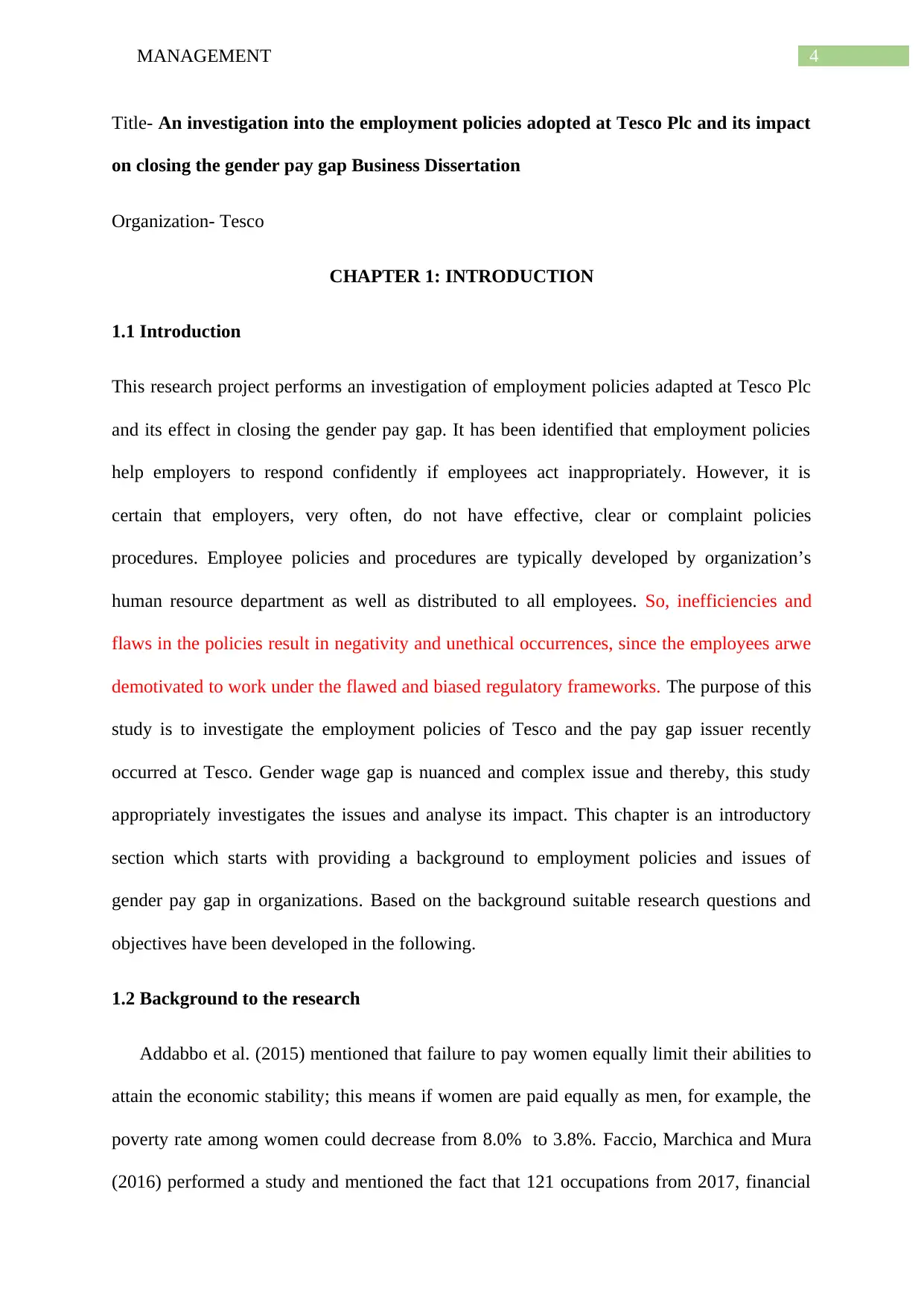
4MANAGEMENT
Title- An investigation into the employment policies adopted at Tesco Plc and its impact
on closing the gender pay gap Business Dissertation
Organization- Tesco
CHAPTER 1: INTRODUCTION
1.1 Introduction
This research project performs an investigation of employment policies adapted at Tesco Plc
and its effect in closing the gender pay gap. It has been identified that employment policies
help employers to respond confidently if employees act inappropriately. However, it is
certain that employers, very often, do not have effective, clear or complaint policies
procedures. Employee policies and procedures are typically developed by organization’s
human resource department as well as distributed to all employees. So, inefficiencies and
flaws in the policies result in negativity and unethical occurrences, since the employees arwe
demotivated to work under the flawed and biased regulatory frameworks. The purpose of this
study is to investigate the employment policies of Tesco and the pay gap issuer recently
occurred at Tesco. Gender wage gap is nuanced and complex issue and thereby, this study
appropriately investigates the issues and analyse its impact. This chapter is an introductory
section which starts with providing a background to employment policies and issues of
gender pay gap in organizations. Based on the background suitable research questions and
objectives have been developed in the following.
1.2 Background to the research
Addabbo et al. (2015) mentioned that failure to pay women equally limit their abilities to
attain the economic stability; this means if women are paid equally as men, for example, the
poverty rate among women could decrease from 8.0% to 3.8%. Faccio, Marchica and Mura
(2016) performed a study and mentioned the fact that 121 occupations from 2017, financial
Title- An investigation into the employment policies adopted at Tesco Plc and its impact
on closing the gender pay gap Business Dissertation
Organization- Tesco
CHAPTER 1: INTRODUCTION
1.1 Introduction
This research project performs an investigation of employment policies adapted at Tesco Plc
and its effect in closing the gender pay gap. It has been identified that employment policies
help employers to respond confidently if employees act inappropriately. However, it is
certain that employers, very often, do not have effective, clear or complaint policies
procedures. Employee policies and procedures are typically developed by organization’s
human resource department as well as distributed to all employees. So, inefficiencies and
flaws in the policies result in negativity and unethical occurrences, since the employees arwe
demotivated to work under the flawed and biased regulatory frameworks. The purpose of this
study is to investigate the employment policies of Tesco and the pay gap issuer recently
occurred at Tesco. Gender wage gap is nuanced and complex issue and thereby, this study
appropriately investigates the issues and analyse its impact. This chapter is an introductory
section which starts with providing a background to employment policies and issues of
gender pay gap in organizations. Based on the background suitable research questions and
objectives have been developed in the following.
1.2 Background to the research
Addabbo et al. (2015) mentioned that failure to pay women equally limit their abilities to
attain the economic stability; this means if women are paid equally as men, for example, the
poverty rate among women could decrease from 8.0% to 3.8%. Faccio, Marchica and Mura
(2016) performed a study and mentioned the fact that 121 occupations from 2017, financial
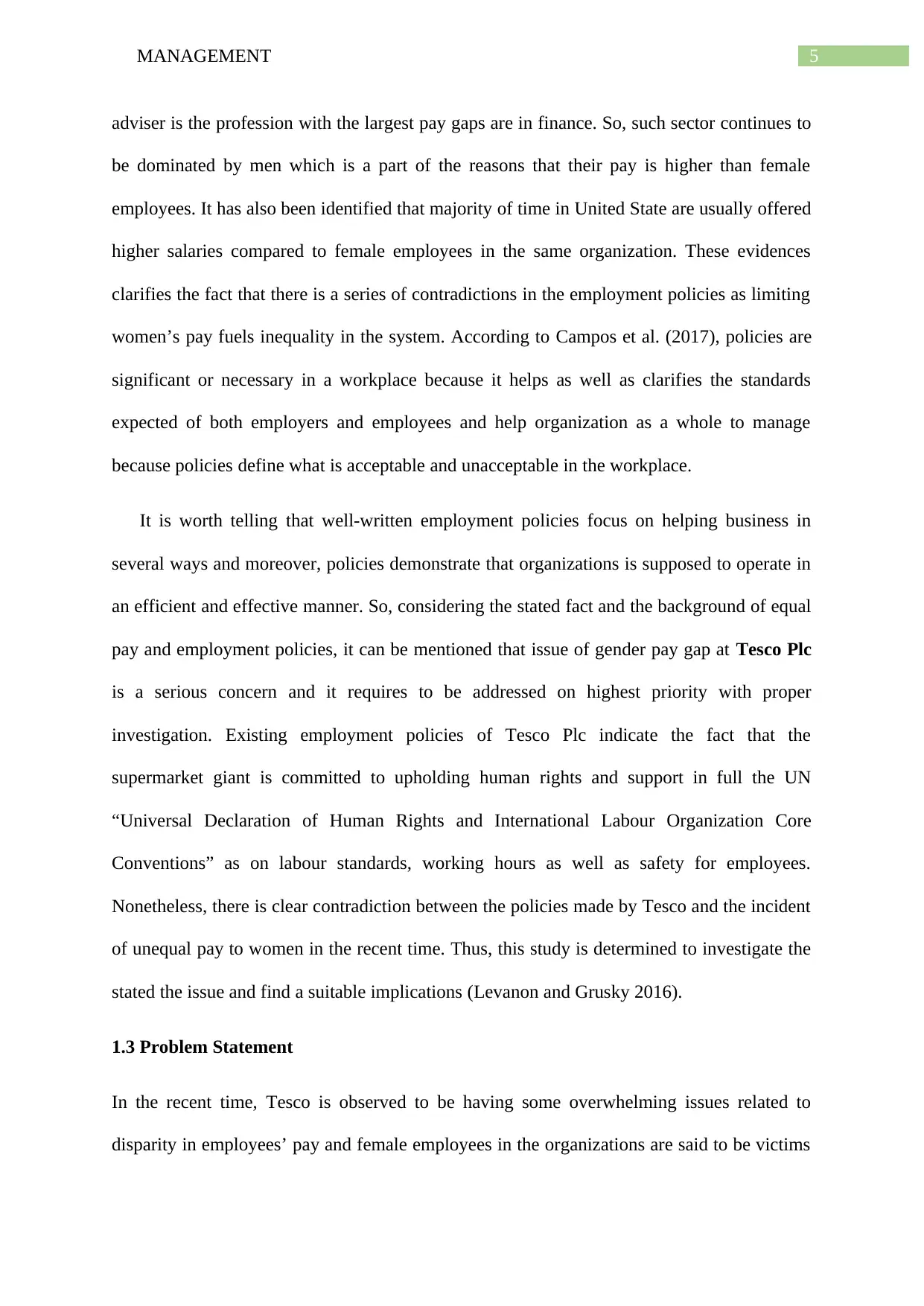
5MANAGEMENT
adviser is the profession with the largest pay gaps are in finance. So, such sector continues to
be dominated by men which is a part of the reasons that their pay is higher than female
employees. It has also been identified that majority of time in United State are usually offered
higher salaries compared to female employees in the same organization. These evidences
clarifies the fact that there is a series of contradictions in the employment policies as limiting
women’s pay fuels inequality in the system. According to Campos et al. (2017), policies are
significant or necessary in a workplace because it helps as well as clarifies the standards
expected of both employers and employees and help organization as a whole to manage
because policies define what is acceptable and unacceptable in the workplace.
It is worth telling that well-written employment policies focus on helping business in
several ways and moreover, policies demonstrate that organizations is supposed to operate in
an efficient and effective manner. So, considering the stated fact and the background of equal
pay and employment policies, it can be mentioned that issue of gender pay gap at Tesco Plc
is a serious concern and it requires to be addressed on highest priority with proper
investigation. Existing employment policies of Tesco Plc indicate the fact that the
supermarket giant is committed to upholding human rights and support in full the UN
“Universal Declaration of Human Rights and International Labour Organization Core
Conventions” as on labour standards, working hours as well as safety for employees.
Nonetheless, there is clear contradiction between the policies made by Tesco and the incident
of unequal pay to women in the recent time. Thus, this study is determined to investigate the
stated the issue and find a suitable implications (Levanon and Grusky 2016).
1.3 Problem Statement
In the recent time, Tesco is observed to be having some overwhelming issues related to
disparity in employees’ pay and female employees in the organizations are said to be victims
adviser is the profession with the largest pay gaps are in finance. So, such sector continues to
be dominated by men which is a part of the reasons that their pay is higher than female
employees. It has also been identified that majority of time in United State are usually offered
higher salaries compared to female employees in the same organization. These evidences
clarifies the fact that there is a series of contradictions in the employment policies as limiting
women’s pay fuels inequality in the system. According to Campos et al. (2017), policies are
significant or necessary in a workplace because it helps as well as clarifies the standards
expected of both employers and employees and help organization as a whole to manage
because policies define what is acceptable and unacceptable in the workplace.
It is worth telling that well-written employment policies focus on helping business in
several ways and moreover, policies demonstrate that organizations is supposed to operate in
an efficient and effective manner. So, considering the stated fact and the background of equal
pay and employment policies, it can be mentioned that issue of gender pay gap at Tesco Plc
is a serious concern and it requires to be addressed on highest priority with proper
investigation. Existing employment policies of Tesco Plc indicate the fact that the
supermarket giant is committed to upholding human rights and support in full the UN
“Universal Declaration of Human Rights and International Labour Organization Core
Conventions” as on labour standards, working hours as well as safety for employees.
Nonetheless, there is clear contradiction between the policies made by Tesco and the incident
of unequal pay to women in the recent time. Thus, this study is determined to investigate the
stated the issue and find a suitable implications (Levanon and Grusky 2016).
1.3 Problem Statement
In the recent time, Tesco is observed to be having some overwhelming issues related to
disparity in employees’ pay and female employees in the organizations are said to be victims
⊘ This is a preview!⊘
Do you want full access?
Subscribe today to unlock all pages.

Trusted by 1+ million students worldwide
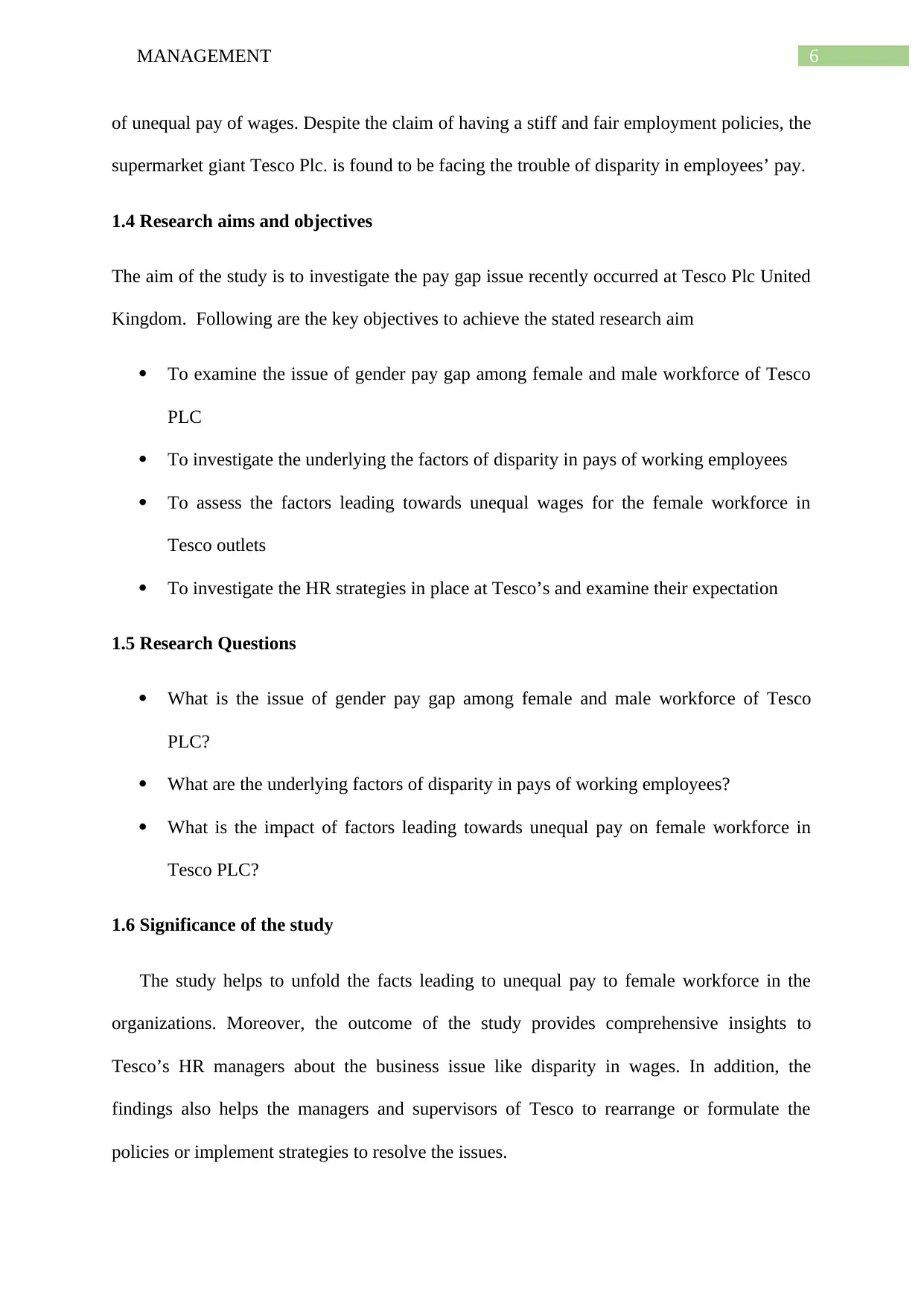
6MANAGEMENT
of unequal pay of wages. Despite the claim of having a stiff and fair employment policies, the
supermarket giant Tesco Plc. is found to be facing the trouble of disparity in employees’ pay.
1.4 Research aims and objectives
The aim of the study is to investigate the pay gap issue recently occurred at Tesco Plc United
Kingdom. Following are the key objectives to achieve the stated research aim
To examine the issue of gender pay gap among female and male workforce of Tesco
PLC
To investigate the underlying the factors of disparity in pays of working employees
To assess the factors leading towards unequal wages for the female workforce in
Tesco outlets
To investigate the HR strategies in place at Tesco’s and examine their expectation
1.5 Research Questions
What is the issue of gender pay gap among female and male workforce of Tesco
PLC?
What are the underlying factors of disparity in pays of working employees?
What is the impact of factors leading towards unequal pay on female workforce in
Tesco PLC?
1.6 Significance of the study
The study helps to unfold the facts leading to unequal pay to female workforce in the
organizations. Moreover, the outcome of the study provides comprehensive insights to
Tesco’s HR managers about the business issue like disparity in wages. In addition, the
findings also helps the managers and supervisors of Tesco to rearrange or formulate the
policies or implement strategies to resolve the issues.
of unequal pay of wages. Despite the claim of having a stiff and fair employment policies, the
supermarket giant Tesco Plc. is found to be facing the trouble of disparity in employees’ pay.
1.4 Research aims and objectives
The aim of the study is to investigate the pay gap issue recently occurred at Tesco Plc United
Kingdom. Following are the key objectives to achieve the stated research aim
To examine the issue of gender pay gap among female and male workforce of Tesco
PLC
To investigate the underlying the factors of disparity in pays of working employees
To assess the factors leading towards unequal wages for the female workforce in
Tesco outlets
To investigate the HR strategies in place at Tesco’s and examine their expectation
1.5 Research Questions
What is the issue of gender pay gap among female and male workforce of Tesco
PLC?
What are the underlying factors of disparity in pays of working employees?
What is the impact of factors leading towards unequal pay on female workforce in
Tesco PLC?
1.6 Significance of the study
The study helps to unfold the facts leading to unequal pay to female workforce in the
organizations. Moreover, the outcome of the study provides comprehensive insights to
Tesco’s HR managers about the business issue like disparity in wages. In addition, the
findings also helps the managers and supervisors of Tesco to rearrange or formulate the
policies or implement strategies to resolve the issues.
Paraphrase This Document
Need a fresh take? Get an instant paraphrase of this document with our AI Paraphraser
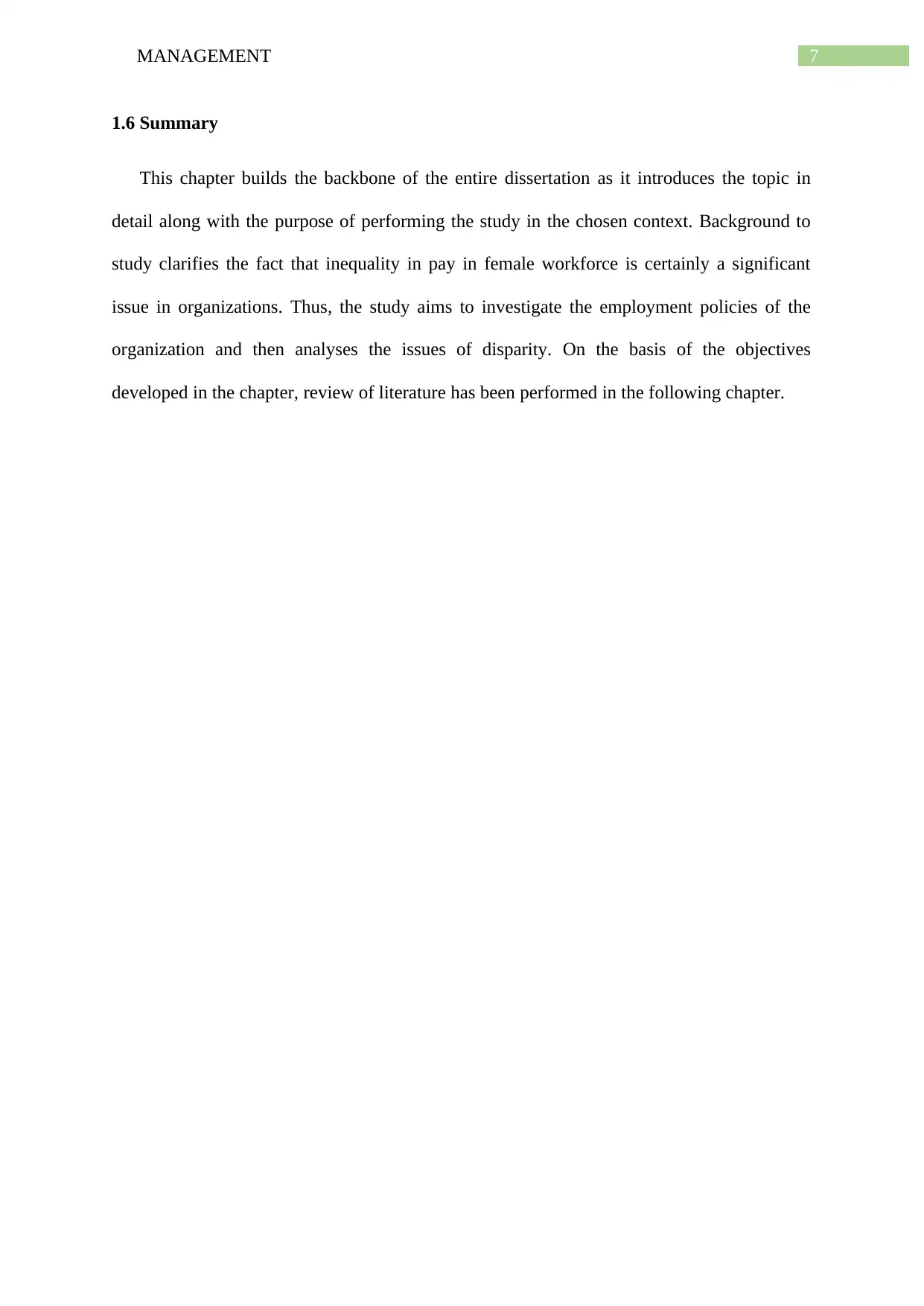
7MANAGEMENT
1.6 Summary
This chapter builds the backbone of the entire dissertation as it introduces the topic in
detail along with the purpose of performing the study in the chosen context. Background to
study clarifies the fact that inequality in pay in female workforce is certainly a significant
issue in organizations. Thus, the study aims to investigate the employment policies of the
organization and then analyses the issues of disparity. On the basis of the objectives
developed in the chapter, review of literature has been performed in the following chapter.
1.6 Summary
This chapter builds the backbone of the entire dissertation as it introduces the topic in
detail along with the purpose of performing the study in the chosen context. Background to
study clarifies the fact that inequality in pay in female workforce is certainly a significant
issue in organizations. Thus, the study aims to investigate the employment policies of the
organization and then analyses the issues of disparity. On the basis of the objectives
developed in the chapter, review of literature has been performed in the following chapter.
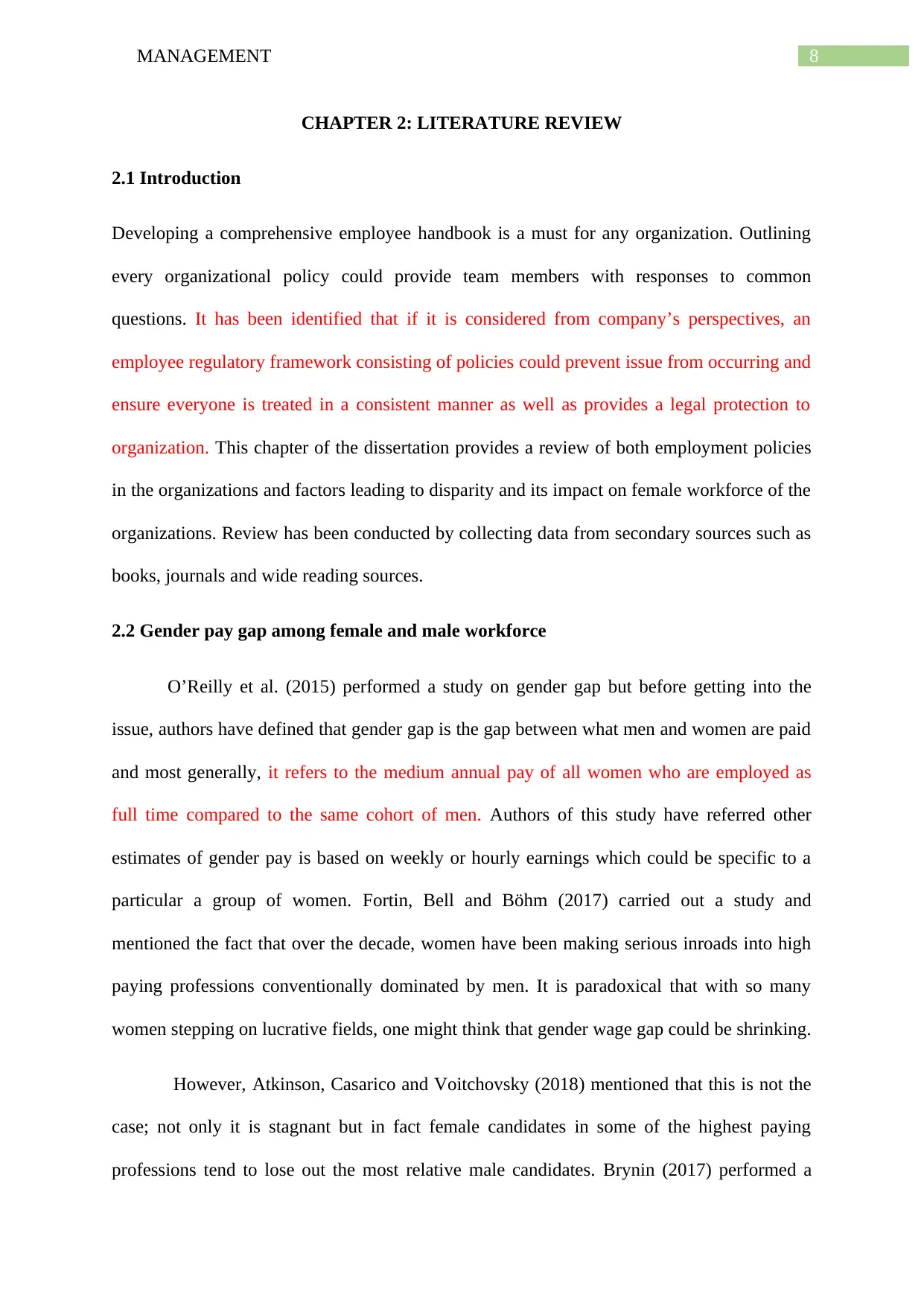
8MANAGEMENT
CHAPTER 2: LITERATURE REVIEW
2.1 Introduction
Developing a comprehensive employee handbook is a must for any organization. Outlining
every organizational policy could provide team members with responses to common
questions. It has been identified that if it is considered from company’s perspectives, an
employee regulatory framework consisting of policies could prevent issue from occurring and
ensure everyone is treated in a consistent manner as well as provides a legal protection to
organization. This chapter of the dissertation provides a review of both employment policies
in the organizations and factors leading to disparity and its impact on female workforce of the
organizations. Review has been conducted by collecting data from secondary sources such as
books, journals and wide reading sources.
2.2 Gender pay gap among female and male workforce
O’Reilly et al. (2015) performed a study on gender gap but before getting into the
issue, authors have defined that gender gap is the gap between what men and women are paid
and most generally, it refers to the medium annual pay of all women who are employed as
full time compared to the same cohort of men. Authors of this study have referred other
estimates of gender pay is based on weekly or hourly earnings which could be specific to a
particular a group of women. Fortin, Bell and Böhm (2017) carried out a study and
mentioned the fact that over the decade, women have been making serious inroads into high
paying professions conventionally dominated by men. It is paradoxical that with so many
women stepping on lucrative fields, one might think that gender wage gap could be shrinking.
However, Atkinson, Casarico and Voitchovsky (2018) mentioned that this is not the
case; not only it is stagnant but in fact female candidates in some of the highest paying
professions tend to lose out the most relative male candidates. Brynin (2017) performed a
CHAPTER 2: LITERATURE REVIEW
2.1 Introduction
Developing a comprehensive employee handbook is a must for any organization. Outlining
every organizational policy could provide team members with responses to common
questions. It has been identified that if it is considered from company’s perspectives, an
employee regulatory framework consisting of policies could prevent issue from occurring and
ensure everyone is treated in a consistent manner as well as provides a legal protection to
organization. This chapter of the dissertation provides a review of both employment policies
in the organizations and factors leading to disparity and its impact on female workforce of the
organizations. Review has been conducted by collecting data from secondary sources such as
books, journals and wide reading sources.
2.2 Gender pay gap among female and male workforce
O’Reilly et al. (2015) performed a study on gender gap but before getting into the
issue, authors have defined that gender gap is the gap between what men and women are paid
and most generally, it refers to the medium annual pay of all women who are employed as
full time compared to the same cohort of men. Authors of this study have referred other
estimates of gender pay is based on weekly or hourly earnings which could be specific to a
particular a group of women. Fortin, Bell and Böhm (2017) carried out a study and
mentioned the fact that over the decade, women have been making serious inroads into high
paying professions conventionally dominated by men. It is paradoxical that with so many
women stepping on lucrative fields, one might think that gender wage gap could be shrinking.
However, Atkinson, Casarico and Voitchovsky (2018) mentioned that this is not the
case; not only it is stagnant but in fact female candidates in some of the highest paying
professions tend to lose out the most relative male candidates. Brynin (2017) performed a
⊘ This is a preview!⊘
Do you want full access?
Subscribe today to unlock all pages.

Trusted by 1+ million students worldwide
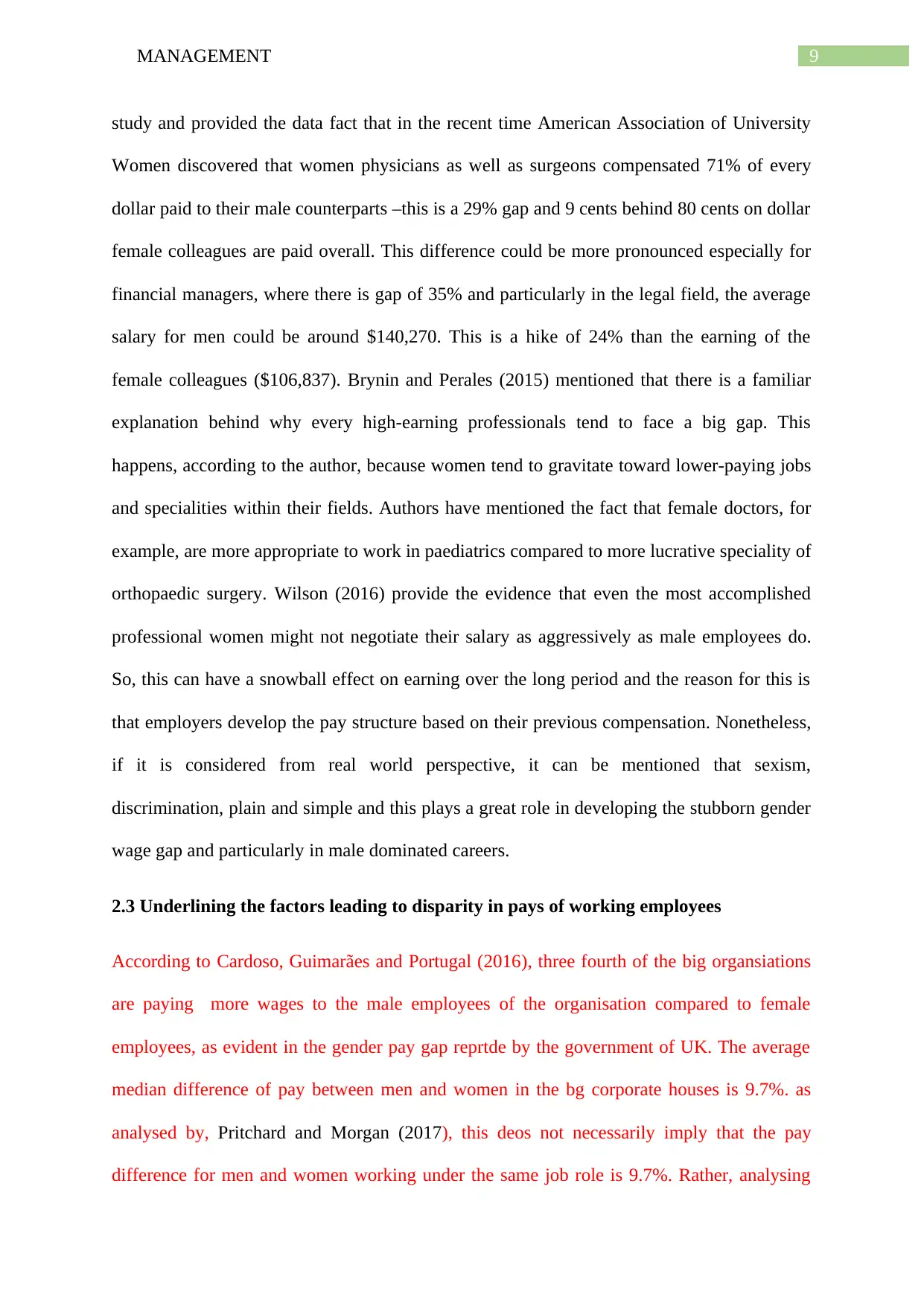
9MANAGEMENT
study and provided the data fact that in the recent time American Association of University
Women discovered that women physicians as well as surgeons compensated 71% of every
dollar paid to their male counterparts –this is a 29% gap and 9 cents behind 80 cents on dollar
female colleagues are paid overall. This difference could be more pronounced especially for
financial managers, where there is gap of 35% and particularly in the legal field, the average
salary for men could be around $140,270. This is a hike of 24% than the earning of the
female colleagues ($106,837). Brynin and Perales (2015) mentioned that there is a familiar
explanation behind why every high-earning professionals tend to face a big gap. This
happens, according to the author, because women tend to gravitate toward lower-paying jobs
and specialities within their fields. Authors have mentioned the fact that female doctors, for
example, are more appropriate to work in paediatrics compared to more lucrative speciality of
orthopaedic surgery. Wilson (2016) provide the evidence that even the most accomplished
professional women might not negotiate their salary as aggressively as male employees do.
So, this can have a snowball effect on earning over the long period and the reason for this is
that employers develop the pay structure based on their previous compensation. Nonetheless,
if it is considered from real world perspective, it can be mentioned that sexism,
discrimination, plain and simple and this plays a great role in developing the stubborn gender
wage gap and particularly in male dominated careers.
2.3 Underlining the factors leading to disparity in pays of working employees
According to Cardoso, Guimarães and Portugal (2016), three fourth of the big organsiations
are paying more wages to the male employees of the organisation compared to female
employees, as evident in the gender pay gap reprtde by the government of UK. The average
median difference of pay between men and women in the bg corporate houses is 9.7%. as
analysed by, Pritchard and Morgan (2017), this deos not necessarily imply that the pay
difference for men and women working under the same job role is 9.7%. Rather, analysing
study and provided the data fact that in the recent time American Association of University
Women discovered that women physicians as well as surgeons compensated 71% of every
dollar paid to their male counterparts –this is a 29% gap and 9 cents behind 80 cents on dollar
female colleagues are paid overall. This difference could be more pronounced especially for
financial managers, where there is gap of 35% and particularly in the legal field, the average
salary for men could be around $140,270. This is a hike of 24% than the earning of the
female colleagues ($106,837). Brynin and Perales (2015) mentioned that there is a familiar
explanation behind why every high-earning professionals tend to face a big gap. This
happens, according to the author, because women tend to gravitate toward lower-paying jobs
and specialities within their fields. Authors have mentioned the fact that female doctors, for
example, are more appropriate to work in paediatrics compared to more lucrative speciality of
orthopaedic surgery. Wilson (2016) provide the evidence that even the most accomplished
professional women might not negotiate their salary as aggressively as male employees do.
So, this can have a snowball effect on earning over the long period and the reason for this is
that employers develop the pay structure based on their previous compensation. Nonetheless,
if it is considered from real world perspective, it can be mentioned that sexism,
discrimination, plain and simple and this plays a great role in developing the stubborn gender
wage gap and particularly in male dominated careers.
2.3 Underlining the factors leading to disparity in pays of working employees
According to Cardoso, Guimarães and Portugal (2016), three fourth of the big organsiations
are paying more wages to the male employees of the organisation compared to female
employees, as evident in the gender pay gap reprtde by the government of UK. The average
median difference of pay between men and women in the bg corporate houses is 9.7%. as
analysed by, Pritchard and Morgan (2017), this deos not necessarily imply that the pay
difference for men and women working under the same job role is 9.7%. Rather, analysing
Paraphrase This Document
Need a fresh take? Get an instant paraphrase of this document with our AI Paraphraser
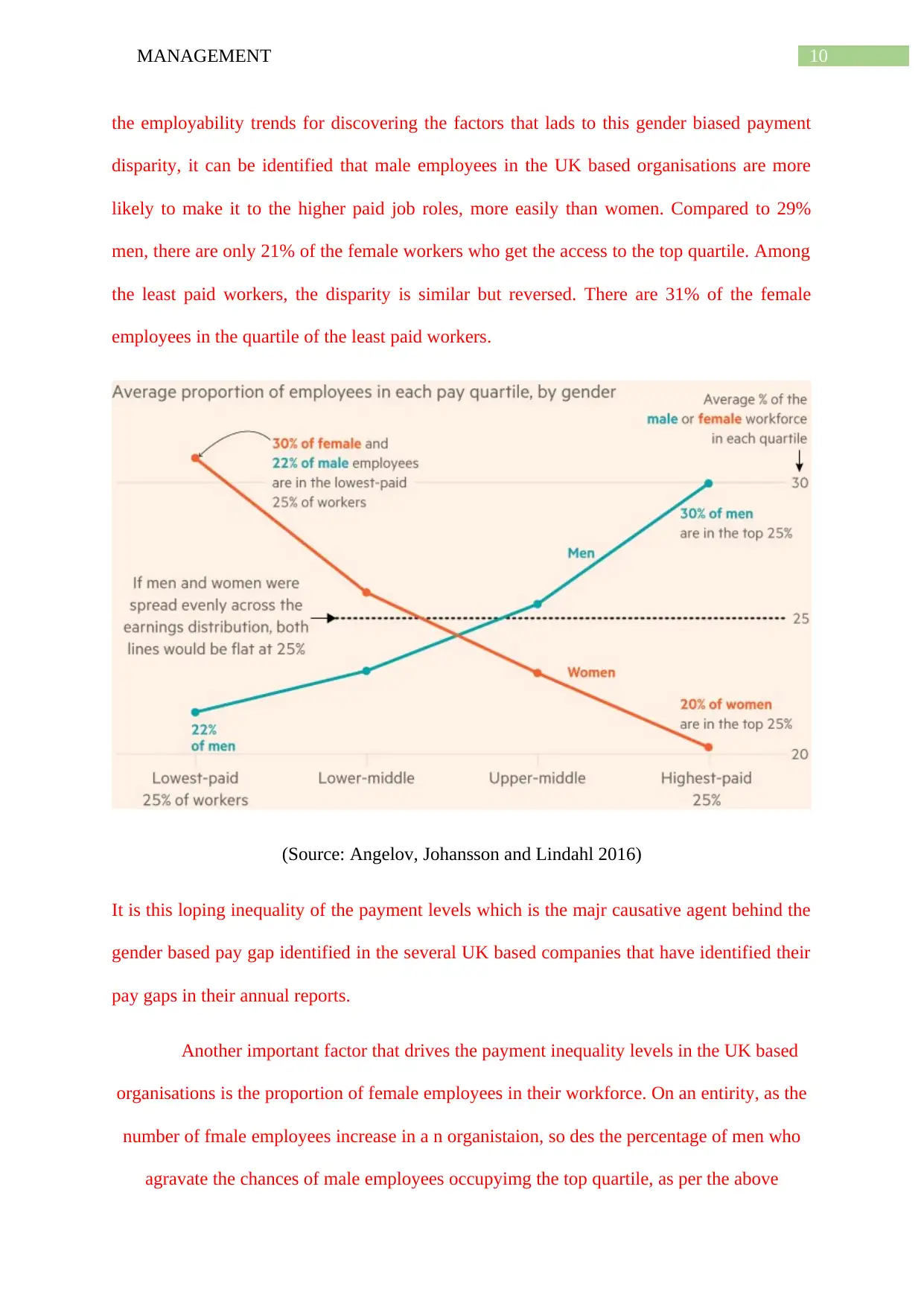
10MANAGEMENT
the employability trends for discovering the factors that lads to this gender biased payment
disparity, it can be identified that male employees in the UK based organisations are more
likely to make it to the higher paid job roles, more easily than women. Compared to 29%
men, there are only 21% of the female workers who get the access to the top quartile. Among
the least paid workers, the disparity is similar but reversed. There are 31% of the female
employees in the quartile of the least paid workers.
(Source: Angelov, Johansson and Lindahl 2016)
It is this loping inequality of the payment levels which is the majr causative agent behind the
gender based pay gap identified in the several UK based companies that have identified their
pay gaps in their annual reports.
Another important factor that drives the payment inequality levels in the UK based
organisations is the proportion of female employees in their workforce. On an entirity, as the
number of fmale employees increase in a n organistaion, so des the percentage of men who
agravate the chances of male employees occupyimg the top quartile, as per the above
the employability trends for discovering the factors that lads to this gender biased payment
disparity, it can be identified that male employees in the UK based organisations are more
likely to make it to the higher paid job roles, more easily than women. Compared to 29%
men, there are only 21% of the female workers who get the access to the top quartile. Among
the least paid workers, the disparity is similar but reversed. There are 31% of the female
employees in the quartile of the least paid workers.
(Source: Angelov, Johansson and Lindahl 2016)
It is this loping inequality of the payment levels which is the majr causative agent behind the
gender based pay gap identified in the several UK based companies that have identified their
pay gaps in their annual reports.
Another important factor that drives the payment inequality levels in the UK based
organisations is the proportion of female employees in their workforce. On an entirity, as the
number of fmale employees increase in a n organistaion, so des the percentage of men who
agravate the chances of male employees occupyimg the top quartile, as per the above
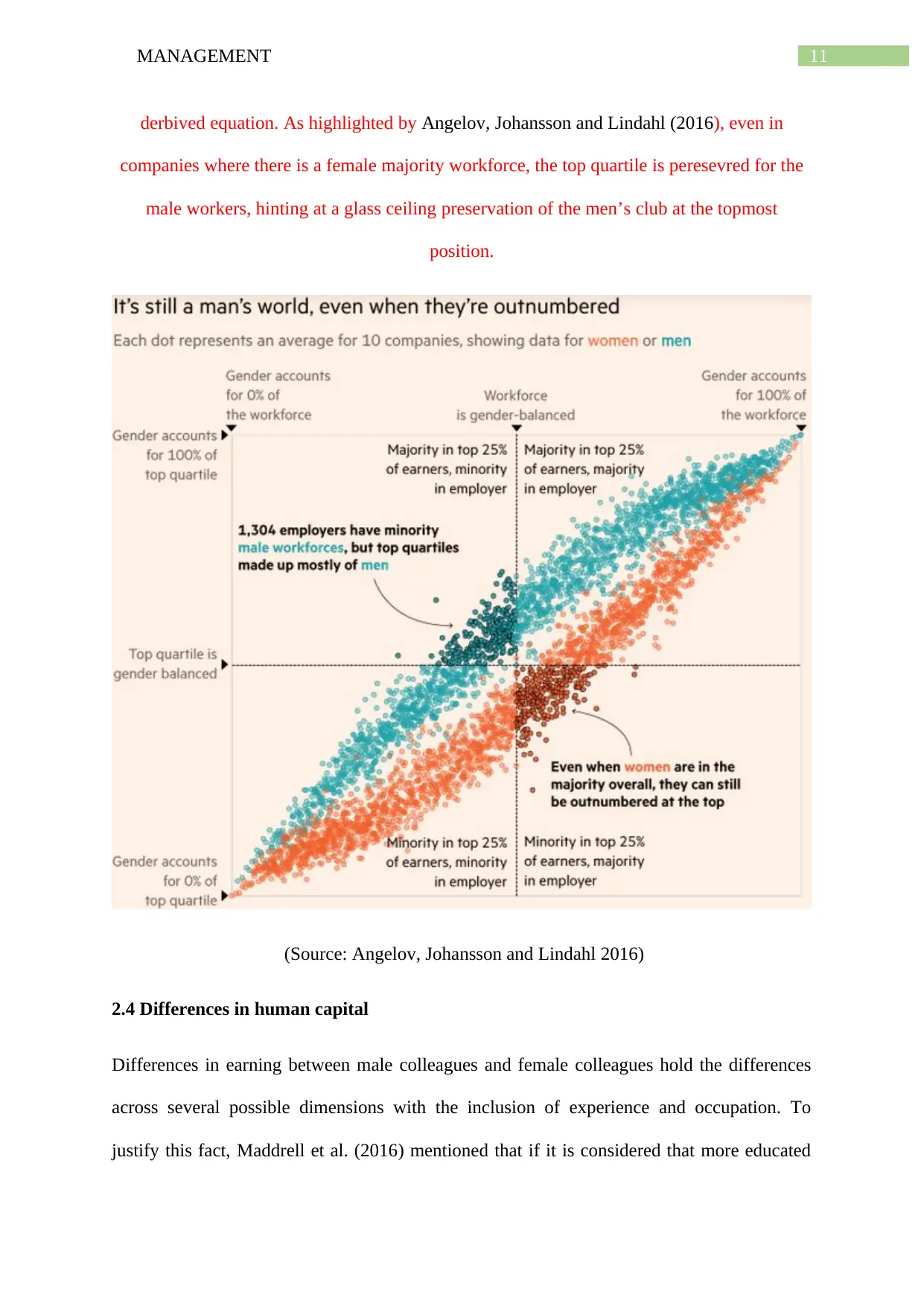
11MANAGEMENT
derbived equation. As highlighted by Angelov, Johansson and Lindahl (2016), even in
companies where there is a female majority workforce, the top quartile is peresevred for the
male workers, hinting at a glass ceiling preservation of the men’s club at the topmost
position.
(Source: Angelov, Johansson and Lindahl 2016)
2.4 Differences in human capital
Differences in earning between male colleagues and female colleagues hold the differences
across several possible dimensions with the inclusion of experience and occupation. To
justify this fact, Maddrell et al. (2016) mentioned that if it is considered that more educated
derbived equation. As highlighted by Angelov, Johansson and Lindahl (2016), even in
companies where there is a female majority workforce, the top quartile is peresevred for the
male workers, hinting at a glass ceiling preservation of the men’s club at the topmost
position.
(Source: Angelov, Johansson and Lindahl 2016)
2.4 Differences in human capital
Differences in earning between male colleagues and female colleagues hold the differences
across several possible dimensions with the inclusion of experience and occupation. To
justify this fact, Maddrell et al. (2016) mentioned that if it is considered that more educated
⊘ This is a preview!⊘
Do you want full access?
Subscribe today to unlock all pages.

Trusted by 1+ million students worldwide
1 out of 39
Related Documents
Your All-in-One AI-Powered Toolkit for Academic Success.
+13062052269
info@desklib.com
Available 24*7 on WhatsApp / Email
![[object Object]](/_next/static/media/star-bottom.7253800d.svg)
Unlock your academic potential
Copyright © 2020–2025 A2Z Services. All Rights Reserved. Developed and managed by ZUCOL.




